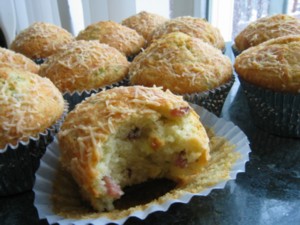 I love savories. I’ll take salty over sweet every time. So when I saw parmesan muffins in Gourmet a few months ago, I figured that might be an easy but festive thing to make for xmas gifts for littlelee & spleen. They came out cute, with their shaggy shredded topping, and they seemed to go over well, but I never got to taste one. So when IMBB went cupcake, I knew I had to make the recipe again. But this time, I embellished.
I love savories. I’ll take salty over sweet every time. So when I saw parmesan muffins in Gourmet a few months ago, I figured that might be an easy but festive thing to make for xmas gifts for littlelee & spleen. They came out cute, with their shaggy shredded topping, and they seemed to go over well, but I never got to taste one. So when IMBB went cupcake, I knew I had to make the recipe again. But this time, I embellished.
I had scallions left over from a fit of chinese cookery, and there was some ham end as well, so I diced them up small and used them in place of the rosemary in the original recipe. The muffins themselves came out quite light, and have an almost cakey texture, so I think of them more as little savory cupcakes rather than muffins, which I normally find rather dense and hefty. I took this batch over to some friends’ house for a brunchtime visit to their new baby, and we ate them with a bit of cheese and fruit for a light meal. This recipe is staying in the repertoire — it’s quick and easy, and what’s not to like about adorable little cheesy pastries?
2 eggs
3/4 cup milk (I used 1%)
1/2 cup e.v. olive oil
1 cup grated parmesan (I of course used extra, and subbed romano)
1.5 cups all purpose flour
2 tbsp sugar (I may skip the sugar next time & see if they are even more savory)
2 tsp baking powder
1/4 tsp baking soda
1 tsp finely chopped garlic (about one large clove)
1 tsp finely chopped fresh rosemary (i subbed 1-2 finely chopped scallions and about half a cup of finely diced deli ham)
3/4 tsp salt
1/2 tsp black pepper
Preheat 350F. Whisk eggs, milk & oil. In another bowl, whisk half the cheese or slightly more than half with all other dry ingredients, then add wet ingredients to dry. Whisk to blend. Line 12-hole muffin pan with paper liners and divide batter among them. Top with the rest of the cheese. Bake 20-25 minutes until tester comes out clean and tops are nice and golden. I checked mine at 20 min, and thought they needed 1 or 2 more minutes; they were a bit pale on top and the tester was clean but moist. But cleverly I neglected to put the timer on and sat down to share a bit of tallasiandude’s breakfast — at least 5 minutes later I jumped up with a shriek and yanked them out of the oven, fearing a panful of cinders. But they were just nicely golden and crunchy on top, so I guess this recipe is pretty forgiving. *grin*
Category: In the Kitchen
foodNERD
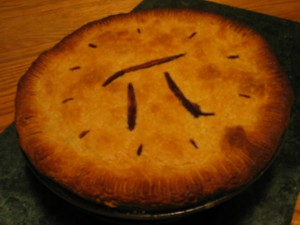
post-race feed
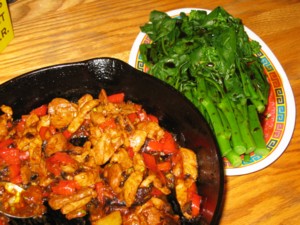 tallasiandude ran a half-marathon this morning, and for various reasons didn’t manage to eat well the rest of the day. Meanwhile I happened to go to the Super 88 Market downtown with my parents and nabbed some good stuff. So I made yu hsiang pork (out of Pei Mei volume I) and chinese broccoli, and a double batch of rice. The pork was nice and spicy-salty, and I put in thin-sliced wood ears and red peppers just for texture and extra flavor, which worked well. I love yu hsiang dishes even in crappy restaurants, so I think this one is going into regular rotation along with the beef & broccoli recipe. The chinese broccoli, which has to be one of my favorite vegetables, was just blanched and drizzled with oyster sauce mixed with a little soy sauce to thin it down.
tallasiandude ran a half-marathon this morning, and for various reasons didn’t manage to eat well the rest of the day. Meanwhile I happened to go to the Super 88 Market downtown with my parents and nabbed some good stuff. So I made yu hsiang pork (out of Pei Mei volume I) and chinese broccoli, and a double batch of rice. The pork was nice and spicy-salty, and I put in thin-sliced wood ears and red peppers just for texture and extra flavor, which worked well. I love yu hsiang dishes even in crappy restaurants, so I think this one is going into regular rotation along with the beef & broccoli recipe. The chinese broccoli, which has to be one of my favorite vegetables, was just blanched and drizzled with oyster sauce mixed with a little soy sauce to thin it down.
8-10 oz pork, boneless, cut into thin strips
2 tbsp wood ear
half a red bell pepper
1 tbsp soy sauce
1 tbsp corn starch
vegetable oil to fry
2 tsp chopped ginger (I used 4 small slices)
1 tsp chopped garlic
sauce:
1 tbsp chopped green onion
1 tbsp soy sauce
1 tbsp black chinese vinegar
1 tbsp hot bean paste
1/2 tbsp shaoxing wine
1 tsp sugar
1/2 tsp salt
1 tsp cornstarch
1 tsp sesame oil
1/4 tsp black pepper
Marinate pork in 1 tbsp cornstarch & 1 tbsp soy for 15 min. Soak wood ear in warm water 15 min, then cut out & discard hard stemmy parts, then slice thin. Dice pepper. Mix up the sauce and let stand. Heat a little oil quite hot in a wok or skillet, fry the pork just until not pink, and remove to a plate. Add a bit more oil and fry the pepper, wood ear, ginger & garlic for a minute or so, scraping the pan if necessary. Add the pork back in along with the sauce, and fry until the sauce thickens a bit. Serve with lots of rice.
Noodlefest 2005
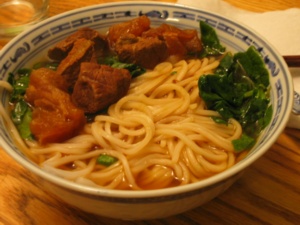
I’ve previously mentioned my love of clear broth soups. But my true love is actually noodle soup.
For some, their idea of comfort foods are things like meatloaf, mac ‘n cheese — which I totally get. But growing up, on those cold, gray and rainy days in southern California (no, seriously), it’d be a bowl of ramen noodles that warmed me up.
In high school, when we were allowed to leave campus, we’d sometimes have back-to-back free periods which would give us an hour and a half to make the half-hour drive down to Chinatown, eat at California Beef Noodle King and then drive the half-hour back just in time for AP E&M.
Yeah, I love me some spicy beef noodle soup.
There are several restaurants in the Boston area that serve nu ro mian (beef meat noodle), but none has ever been quite what I was hoping for. Tai Shiang Garden in Chelmsford was the first — a close enough approximation, but slightly off on both the broth and the noodles (they use what looks like udon). Chung Shin Yuan in Newton and Shangri-la in Belmont have both been pretty good — the broth is almost exactly as I’d like it (with some day-to-day variation), but they both use noodles that remind me of linguine.
A few years ago, I finally decided to take measures into my own hands. I got a recipe for the soup base (beef/tendon and broth) from Mom and tried making it myself. Combined with some fresh noodles bought at the Super 88, we were pretty happy with the results. (I tried making my own hand-pulled noodles, but that experiment was an unmitigated disaster.) But we ended up with an awful lot of meat and broth. The solution? Invite friends!
And thus, Noodlefest was born.
The first year, we provided both the beef broth and a pork broth (made from Magic Hocks) for a secondary pork and pickled cabbage option for our non-red meat eating friends. No allowances were made for the vegetarians. (Sorry guys, but you can’t please all of the people all of the time.) We suffered through a few logistical problems — inadequate rate of noodle availability, bowl shortages, and the pork broth wasn’t quite up to expectations (guests were happy, we were disappointed) — but overall, things went well.
That year, we also tried to cap the number of guests, fearing that we’d run out of soupy goodness. It was close, but things worked out fine, and I think we ended up having soup noodles for an extra couple of days.
Emboldened by the previous year’s success, this year, we decided to step it up a notch: open invite, make more food.
We had a better handle on how much food we needed. We figured that we had ironed out some of the logistical problems that we had had with production. We even did a few preliminary trials of broth for the pork and pickled cabbage.
And to address our tableware resource issue, we made it BYOB — bring your own bowl. (We still bought extra chopsticks and soup spoons.)
So, here’s the beef:
(the numbers in parentheses are the original amounts used to make a normal batch.)
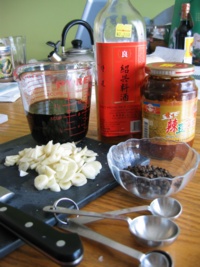
Soy, wine, paste, garlic, peppercorns.
(1-1/2) -> 5+ lbs. Stewing Beef
(1) -> 2 lbs. Beef tendon
(5) -> 15 cloves garlic
(5) -> 15 green onions
(5) ->15 slices ginger (probably 1/8″ cross-sections)
(3) -> 9 star anise
(1) -> 3 T brown peppercorns
(3/4) ->2 cups soysauce
(2) -> 6 T wine
(1/2) -> 1 cup oil (approximate)
(3) -> 9 T hot bean paste
1. Cut beef and tendon into cubes and cook for a minute in boiling water.
Stew beef is convenient here because it’s already mostly cut up for you. I ended up cutting some of the pieces down. I’d also recommend getting the tendon cut for you at the market.
As an experiment, I tried cooking the larger pieces of tendon and then cutting them up after the first hour of cooking, but I don’t feel like the flavor got into the tendon as quickly, and it seemed to take a little longer to cook sufficiently.
Incidentally, I think that the tendon is ESSENTIAL for this recipe even though there are plenty of people that are grossed out by it. Even cooked, people seem to find its fatty, gelatinous appearance to be unappetizing. But it’s this soft, almost melt-in-your-mouth texture when it’s at its most delicious. It’s yummy like fat, except that it’s not bad for you because it’s tendon, which is, as I’ve learned in my physiology class, all connective tissue, which is PROTEIN! (Not that I think fat is really that bad for you, but I realize that it’s not a popularly held belief.)
Anyway, moving on…
2. Drain off the water and return beef to pot. Add boiling water to 2″ above beef. (I find it convenient to actually have 2 large pots of boiling water so you don’t have to wait for the water to come up to boil again.) Add anise, green onion and ginger. Use low heat and stew covered about 1 hour.
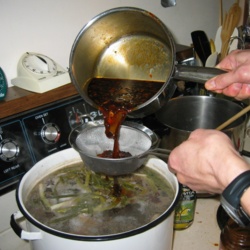
3. Heat oil in another pan, when hot add the garlic and peppercorns and stir fry till brown. Then add hot bean paste, soysauce and wine. Bring to boil, then lower heat and cook for 2 minutes.
And now a word here about the bean paste. When we first tried to make this recipe, the bean paste was probably the hardest thing to get. Not because it was hard to find. No, the problem was that when we got to the sauce aisle in the Super 88, FoodNerd and I were confronted with a whole section of spicy bean pastes, different brands, different beans, different ingredients. We ended up leaving the store with two bottles and have since decided that Ming Teh brand broad bean paste with chili was the way to go.
4. Strain oil mixture into the beef pot and stew until beef is tender.
The original recipe said something like another two hours, but we’ve found that it takes about six for the tendon to really soften up.
The pork noodle soup broth is a bit simpler. It’s a basic chicken stock supplemented with a little ham to round out the flavor. The goal was for it to have a rich, savory flavor while still being clean and light. I think the key ingredients are the ginger, cooking wine and white pepper. It’s got to be good and peppery.
2 lbs chicken
1/2 lb Virginia ham (salty country ham)
5 green onions
5 slices ginger
1 cup cooking wine
white pepper
salt
The above is only an approximation — we mostly did things by taste.
We first par-boiled the chicken and ham the same way we handled the beef in the beef broth. It’s a nice way to get some of the gross stuff out of the meat. After replacing the meat into a fresh pot of boiling water (we topped off a 2-gallon stockpot), we added the green onions, ginger and cooking wine and then reduced heat to a simmer.
After cooking for several (4-5) hours, we added a bit more cooking wine and generous amounts of white pepper and salt to taste. Remember your goal: peppery and savory. (FoodNerd says also “piquant.” That’s the last little shot of wine into the broth.)
We also made a second beef broth to supplement the primary stew broth.
A quick run down: beef neck bones, browned in oil in a large stockpot (I think it was FoodNerd’s 3-gallon pot), then sweated (covered) in cooking wine. Filled the pot with water and added ginger (a few slices), green onions (5-6?) and soy (maybe a cup). Cooked the crap out of it. (The usual — bring to boil, then reduce to simmer for, oh, maybe 5-6 hours.) Season to taste with white pepper, salt and more soy. Supplement with chicken broth. (I think I added a 1-quart container of store-bought broth.)
So, those were the broths. For the pork and pickled cabbage, we sliced pork (tenderloin? cutlet? steaks?) into thin strips and marinated in soy sauce, sesame oil, cooking wine and corn starch. This was stir fried at high heat and then added sliced up pickled radish and greens. This has been another difficulty — finding the correct pickled greens. We ended up using a mix of various types without properly documenting them. Sorry. And still we really haven’t found the same type that is used in the restaurant soups.
It all comes together with the noodles. As mentioned, my chief complaint with the commercial sources of these dishes is that they use substandard noodles. That’s what it’s all about. It can make or break the dish for me.
Since making them myself has proven to be a non-starter, the next best thing has been to buy fresh noodles from the the 88. I’ve liked two brands, and both are simple flour noodles that are labelled as “thin Shanghai style” noodles. (The Twin Marquis brand that calls them “plain noodles (thin)” actually labels them as Shanghai noodles in Chinese characters. Amazingly, my studying hasn’t gone completely to waste!)
The previous year, I was trying to cook the noodles to order. I’d throw a bundle in for 2-3 people, cook them up and then fish them out. I’m not sure what I was thinking — like I was expecting a bunch of people to come in, and half of them would say something like: “Hey, noodles. Cool! Do you mind if I just hang out here and watch some of y’all eat?” Yeah, so cooking small batches of noodles one at a time — dumb idea. I’m inviting people to Noodlefest. When they show up, they’re all gonna want to eat noodles.
Duh.
I ended up spending a lot of time trying to fish out a bunch of cooked noodles while the water was still boiling, putting them straight into people’s bowls, and then putting another batch in. And as the evening worn on, not only had I scalded my hands a couple of times, but the cooking water got thick and cloudy with all the loose flour that was on the fresh noodles to keep them from sticking to each other. It was gross. At some point, we ended up dumping the water and starting fresh, which of course took more time.
One of the reasons for this was a lack of burner space. I think we had two giant stockpots on the stove, a skillet with the pork and cabbage and then the pot for cooking noodles. And it was a tight fit since they were all oversized pots.
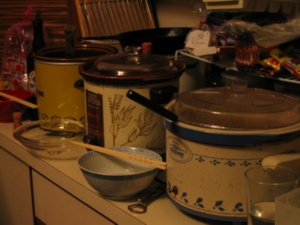
The solution: crockpots!
One crockpot was dedicated to the chicken/pork broth. The other two were used to hold beef broth. The beef and tendon, topped with broth, went into a separate pot. And we precooked the pork and pickled cabbage and put it in a cassarole dish set on a warming tray.
This freed up the stove for two pots in which to boil water for cooking noodles. While one pot was cooking noodles, filled to capacity, we could bring water up to boil in the second pot. A third burner was used to cook down spinach in the beef broth.
When the noodles were cooked, I strained out the water, dumped the noodles back into the pot with cool water to stop the cooking. That’s key: you don’t want the noodles overcooked — it’s important for the noodles to have a little chew to them.
Then, serve into bowls, add spinach and beef (and tendon, for a few), and then top off with broth. Add a dash of chili oil if you want a little extra zip. Similar process for the pork and pickled cabbage, but we let the pork be serve yourself — I just doled out noodles and broth.
A cold and snowy week in February: not the best weather for travelling, but perfect for some noodle soup. We had a few no-shows, but I think we still ended up with over 20 people. Sharing the love.
All told, a good night.
a redemption of sorts
I have been kvetching a lot lately on this blog about my inadequacies with pastry and sweets of all kinds. Normally I have the same trouble with pie crust. My mother has the magic hands, and can just chuck ingredients in and make beautiful crusts by feel. Her mother was even more brilliant. I however generally get floury or oily crapola.
Tonight was different. Tonight was a good crust day. I found a recipe online and just went for it. 2 cups flour, 12 tbsp cold butter cut into chunks, a sprinkle of salt. Cut the works with a pastry cutter (I am finding smearing motions along with cutting motions work well) until finely combined but not completely without chunks. 6 tablespoons cold water (plus more if needed, this time i think i used 7), stir with fork until it starts coming together in parts, then use hands to knead and squeeze gently together until it’s not got any flour left. It barely held together, there were lots of cracks, but I could *feel* the beautiful soft elasticity in the dough. Normally it doesn’t feel anything like that, so I don’t know what I was doing right this time. I squished it together, worrying I was overworking the dough, and rolled it out on a floured marble board. No holes, no insurmountable cracking. I didn’t chill the dough before rolling as most recipes have you do — i just went straight from bowl to roll, and then once the bottom crust was in the pan, i stuck the whole pan in the fridge. Then the top crust went outside into the 40F night, still on the board. Filled crust right from fridge and then straight into the 400F oven.
It came out flaky, crisp and super-buttery (it was an all-butter crust, it oughta be). Imagine that. Yay!
pizza, sort of
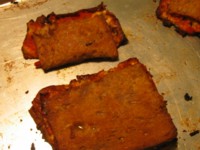 I dug out the Trader Joe’s whole wheat pizza dough from the freezer today, and so my heart got set on pizza for dinner. Per tallasiandude’s pizza preferences and the fact that we had long-leftover pepperoni in the fridge, I made pepperoni & mushroom ‘za. Several things were learned:
I dug out the Trader Joe’s whole wheat pizza dough from the freezer today, and so my heart got set on pizza for dinner. Per tallasiandude’s pizza preferences and the fact that we had long-leftover pepperoni in the fridge, I made pepperoni & mushroom ‘za. Several things were learned:
1. Cento San Marzano passata crushed tomatoes make a fantastic pizza sauce if you sprinkle it with salt, pepper, oregano, a tiny bit of basil, and garlic powder. A lazy girl’s dream.
2. Don’t use an insulated cookie sheet, and do be sure to heat up the pan before putting on the dough if you can. Otherwise you get soggy bottom crust. And then you have to put two pieces on top of each other, douse them in olive oil, and rebake them like faux calzones, flipping the sandwiched pizza lumps to crisp up both crusts. Oops. Still tasted good.
has anybody seen, a quiche dyed dark green?
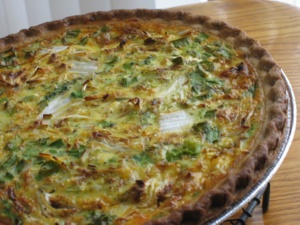 Continuing on the eat-lots-of-veg and spend-little benders I am on these days, I give you a quiche made of leftover napa cabbage sauteed in leftover bacon fat, leftover broccoli, leftover scallion, free extra-sharp cheddar from the parents, leftover cream, 4 eggs, and a lonesome leftover frozen pie shell. With a bit of salt, pepper, nutmeg & savory. Nummy, if a tiny bit watery from slightly undersauteed cabbage. *grin*
Continuing on the eat-lots-of-veg and spend-little benders I am on these days, I give you a quiche made of leftover napa cabbage sauteed in leftover bacon fat, leftover broccoli, leftover scallion, free extra-sharp cheddar from the parents, leftover cream, 4 eggs, and a lonesome leftover frozen pie shell. With a bit of salt, pepper, nutmeg & savory. Nummy, if a tiny bit watery from slightly undersauteed cabbage. *grin*
I should have photographed the stir fry the other night — pork cutlet, broccoli, napa, onion, garlic and ginger, in a plain sauce of shaoxing wine, soy & cornstarch, with a sprinkle of red pepper flakes. It was really good, if I do say so myself. Hee.
faux chex snax
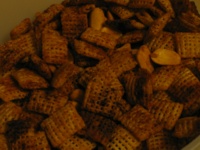 I was seized by a fit of discontentment and restlessness and frustration today, and though I am not generally an emotional eater, I just could not stop looking for something to eat. Since cooking usually keeps hunger at bay for me, and since nothing in the house looked good anyway (I must have PMS), I decided to MAKE a snack. The box of faux Rice Chex had a snack mix recipe, which I adapted liberally, and the result is insane salty spicy goodness. You might want to be less salt-rageous.
I was seized by a fit of discontentment and restlessness and frustration today, and though I am not generally an emotional eater, I just could not stop looking for something to eat. Since cooking usually keeps hunger at bay for me, and since nothing in the house looked good anyway (I must have PMS), I decided to MAKE a snack. The box of faux Rice Chex had a snack mix recipe, which I adapted liberally, and the result is insane salty spicy goodness. You might want to be less salt-rageous.
4 cups chex
some peanuts
2 tbsp butter
2 tsp worcestershire
1-2 tsp hot sauce (Frank’s), to taste
1 tsp or more garlic powder
1/2 tsp onion powder
few dashes chili powder
few pinches salt (I used more than a few)
Melt butter in large bowl in microwave, add seasonings, stir, add chex and peanuts, toss a lot to combine (rubber spatula works well), microwave 2 min, stir again, microwave 2 min, stir again, and if they seem well seasoned and dry enough to be crispy, let them sit until cool enough to eat, otherwise nuke 2 more min then stir and let cool. Mack down as needed. Let the rest dry completely and then put it away in a tupperware.
If you don’t like it as it’s heating, you can sprinkle more stuff directly over it, toss to blend, and keep going — i did that with worcestershire, hot sauce and garlic powder, and salt (which was probably unnecessary, but oversalty got the job done today). This has the advantage of being wheat-free, if you use rice and/or corn chex, which is nice if you are unfortunate enough to be sensitive to it, and really it’s not so much butter, so it’s almost kinda sorta healthy and stuff. Yep, right, uh huh.
IMBB12: Taboo, very late
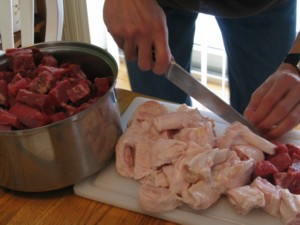 I admit it: I didn’t have the energy to think up a taboo food situation, and I bailed outright. I suck. Reading through the entries for the latest IMBB was extremely cool, and I felt guilty. But then tallasiandude reminded me that NoodleFest ’05 (about which he STILL has to post, hint, nudge) involved something that most of the attendees found fairly icky, but that we love love love: beef tendon.
I admit it: I didn’t have the energy to think up a taboo food situation, and I bailed outright. I suck. Reading through the entries for the latest IMBB was extremely cool, and I felt guilty. But then tallasiandude reminded me that NoodleFest ’05 (about which he STILL has to post, hint, nudge) involved something that most of the attendees found fairly icky, but that we love love love: beef tendon.
Now I always avoided beef tendon in vietnamese soups because it sounded tough, and when tallasiandude named it as a critical ingredient in beef spicy noodle soup, I was wary. And even so, some restaurant versions of beef spicy noodle include tendon that is still quite, um, chewy. And it looks truly scary when raw, as you can see from the picture, especially when you touch it and it feels hard and slippery, almost like bone. And it’s about as hard as bone to cut while it’s raw. But when you stew tendon for hours and hours and hours, it turns soft and gelatinous, with a rich taste and comforting texture, and it is by far the best part of beef spicy noodle soup as far as I’m concerned. Which is good, because our 20+ noodle-guests ate up all 5 pounds of beef, but left lots and lots of lovely tendon floating around in the broth, and so we had tendon spicy noodle soup for several days afterward. Deelish!
EOMEOTE #4
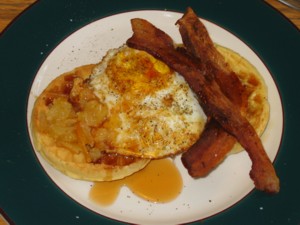 Ahhh, EOMEOTE, my favorite foodblogging event! I love the story behind it, i love the low-rent spirit of it, and i love the eats. *contented sigh* This month, continuing with the spend-less-on-food project currently underway here Chez Foodnerd, I am trying to eat all the stuff I have stashed around my larder. Today breakfast was the last of the frozen waffles that have been kicking around the freezer for well over a year, plus a last bit of magic bacon I forgot about in the fridge, the meyer lemon marmalade I made last week — too thick because I am incompetent with all sugared foods but delicious still, and boiled cider that my mother gave me at Christmas.
Ahhh, EOMEOTE, my favorite foodblogging event! I love the story behind it, i love the low-rent spirit of it, and i love the eats. *contented sigh* This month, continuing with the spend-less-on-food project currently underway here Chez Foodnerd, I am trying to eat all the stuff I have stashed around my larder. Today breakfast was the last of the frozen waffles that have been kicking around the freezer for well over a year, plus a last bit of magic bacon I forgot about in the fridge, the meyer lemon marmalade I made last week — too thick because I am incompetent with all sugared foods but delicious still, and boiled cider that my mother gave me at Christmas.
Waffles are I suppose not technically toast, but I think these qualify for two reasons: 1, they were dredged up out of mealtime desperation, and 2, they were prepared in the toaster. Boiled cider is quite lovely, and I am glad to have the excuse to blog about it — it looks and functions like maple syrup, but it’s got the tangy fruitiness of apples, so it’s much lighter feeling than maple. Tallasiandude didn’t dig it so much; he got out the maple to go with his EOMEOTE, which also he deconstructed so it was more an EOME next to TE. But mine was a salty, bacon-fatty, tangy treat, with the tart lemon and cider sparking up the egg and bacon and waffle into something really rather nice.